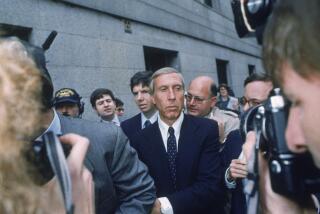The Genealogy of Wall Street Crime
- Share via
The Wall Street and corporate scandals that began with Enron may be astonishing for the scope and audacity of their criminality, but they are not by any means unprecedented. In fact, Wall Street has been dogged by spectacular acts of financial banditry since its earliest days.
The market first crashed in 1792, soon after the nation’s birth, thanks to a merchant prince named William Duer. He was a man of wide-ranging business interests who had supported and made money off the Revolution and who then married into the upper reaches of New York society. He thought he could use his insider connections to Alexander Hamilton to make a killing by speculating in the newly issued debt of the infant government. As so many would after him, Duer overreached. Borrowing heavily to finance his illicit schemes, he went bankrupt when the bubble burst. The New York City economy crashed along with him, and Duer was nearly disemboweled by an enraged mob that chased him through the streets. He died in debtors’ prison a few years later.
Getting chased through the streets, or something close to it, became a rite of passage for Wall Street’s more outrageous malefactors. Daniel Drew, Jay Gould (“the Mephistopheles of Wall Street”) and “Jubilee Jim” Fisk, notoriously unscrupulous speculators around the time of the Civil War, thought nothing of running off endless quantities of Erie Railroad securities on that era’s equivalent of the mimeograph machine, in a conspiracy aimed at wresting control of the railroad from their chief rival, Cornelius Vanderbilt. When a judge ordered their arrest, they barely made it out of town in the middle of the night in a rickety rowboat that nearly capsized in New York Harbor before landing safely in Jersey City.
Instances of financial chicanery with sometimes disastrous consequences -- in one sad case bankrupting Civil War hero and ex-President Ulysses S. Grant -- recurred all through the Gilded Age and thereafter. Things reached a low point during the Jazz Age. Investment pools and other schemes run by Wall Street’s high and mighty -- men such as “Sunshine” Charlie Mitchell, head of National City Bank, then the nation’s largest; William Crapo Durant, the thrice-bankrupted founder of General Motors; Jesse Livermore, Wall Street’s “man with the evil eye”; and Samuel Insull, the public utility magnate -- were studies in insider trading, accounting obfuscation and incestuous relations between commercial and investment banking that fatally compromised both.
With the crash of 1929, some fled the country; others committed suicide. The president of the New York Stock Exchange, Richard Whitney, whose blood lines went back to the Mayflower, whose brother was a senior partner at J.P. Morgan, who had been educated at Groton and Harvard, who hunted foxes and took for granted his right to rule, was carted off to Sing Sing after being convicted of fraud and embezzlement.
From Duer to Whitney, the sorry doings of these businessmen inspired two public responses. One was to lock them up (sometimes preceded by chasing them through the streets). The second was to attempt to treat the institutional roots of the problem through government regulation. The idea was not only to punish wrongdoers but to address big social questions such as economic inequality and the catastrophic depressions that followed these scandals. The Sherman Antitrust Act, the Federal Reserve Act, the Clayton Antitrust Act, the Glass-Steagall Banking Act and the creation of the Securities and Exchange Commission are among the best known of those efforts.
Today, faced by financial meltdowns so stupendous they make previous debacles seem almost benign, we continue to lock people up. But we have nearly abandoned the attempt to address the systemic origins of the disease through legislative reform. The Sarbanes-Oxley Act, which followed the collapse of WorldCom, was quite limited in reach -- yet was nevertheless bitterly attacked by business.
Deregulation triumphed under President Reagan and remains the order of the day. Regulation has been replaced not so much with the free market as with a system of socialized financial risk in which the government bails out speculators with taxpayer money, as in the savings and loan fiasco of the late ‘80s or the Long-Term Capital Management rescue of the mid-’90s.
Complaints about overzealousness on the part of government prosecutors are therefore not only the height of hypocrisy, they betray a willful blindness to the lessons of the past, even when the past is repeating itself all around us.
More to Read
Sign up for Essential California
The most important California stories and recommendations in your inbox every morning.
You may occasionally receive promotional content from the Los Angeles Times.













